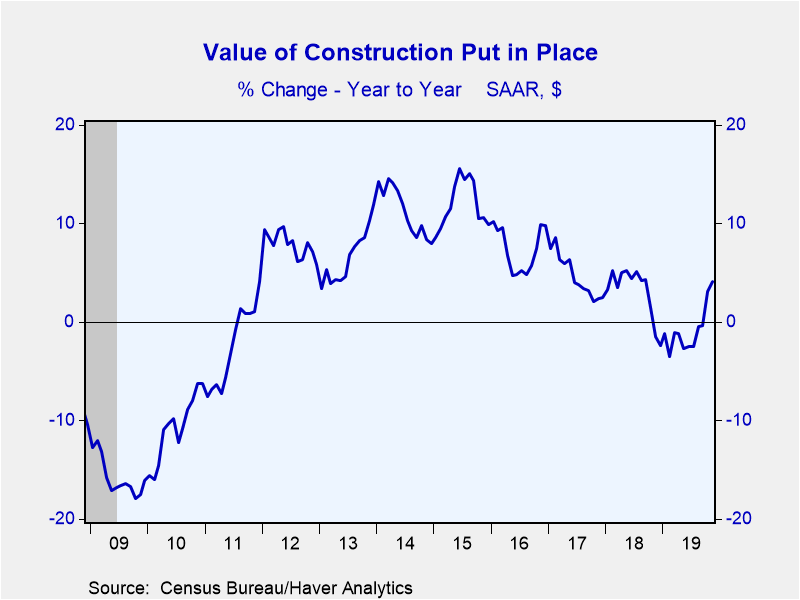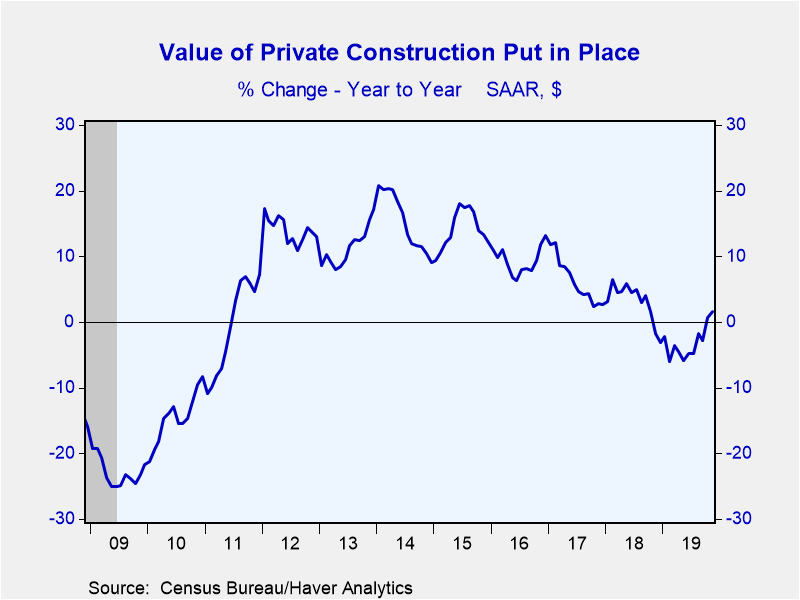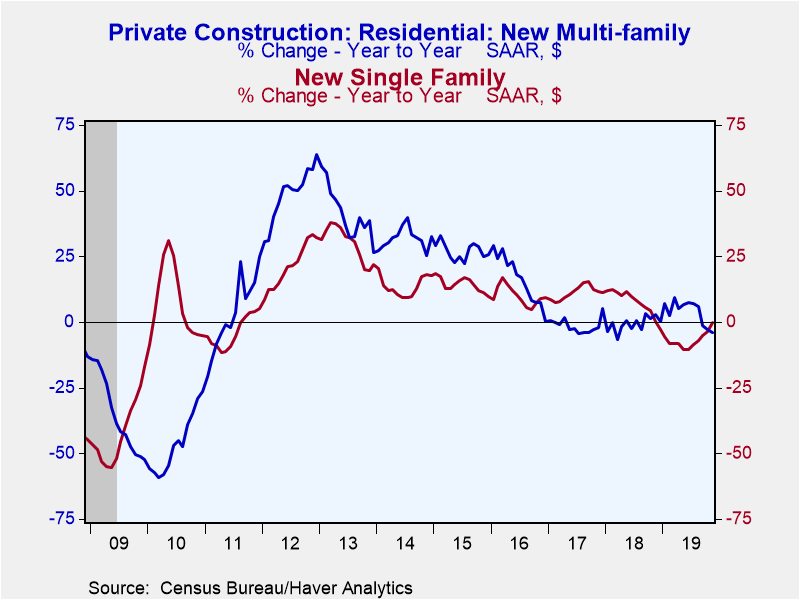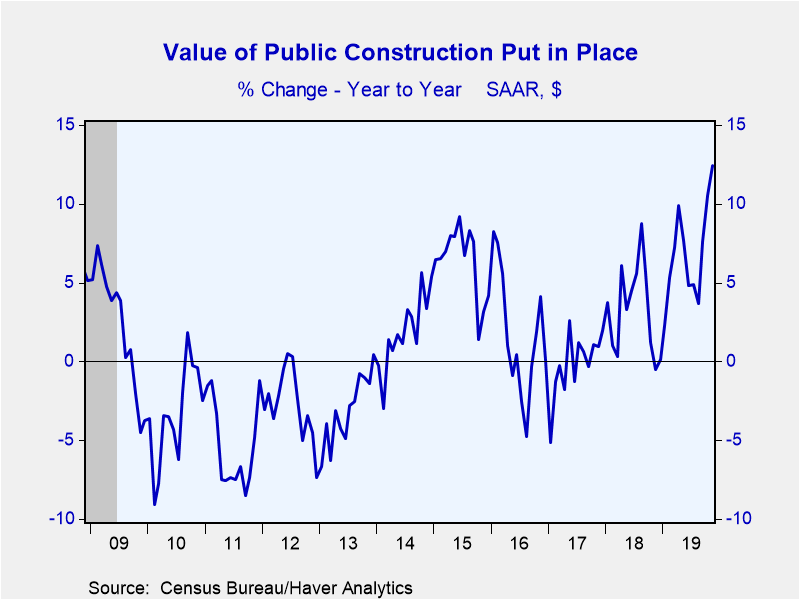 Global| Jan 03 2020
Global| Jan 03 2020U.S. Construction Spending Stronger than Expected in November
by:Sandy Batten
|in:Economy in Brief
Summary
The value of construction put-in-place rose a larger-than-expected 0.6% m/m (+4.1% y/y) in November with significant upward revisions to both October and September. The Action Economics Forecast Survey had looked for a 0.3% m/m rise. [...]
The value of construction put-in-place rose a larger-than-expected 0.6% m/m (+4.1% y/y) in November with significant upward revisions to both October and September. The Action Economics Forecast Survey had looked for a 0.3% m/m rise. As for revisions, the 0.8% m/m decline initially reported for October was revised to a 0.1% m/m gain while the 0.3% m/m decrease previously reported for September was revised up to a 0.7% m/m increase. The revisions were concentrated in private, residential construction.
Private construction rose 0.4% m/m (+1.6% y/y) in November with significant upward revisions to October and September. The initially reported 1.0% m/m decline for October was revised to a 0.1% m/m increase, and the 1.1% decrease previously reported for September was revised to a 0.3% m/m rise. Private residential construction surged 1.9% m/m (2.7% y/y) in November, led by a 3.4% m/m jump in home improvements, but also a 1.2% m/m gain in single family new house building. Multi-family construction was essentially unchanged in November after having fallen in each of the previous three months.
In contrast to residential construction, private nonresidential construction remained weak in November, declining 1.2% m/m (+0.2% y/y), its sixth monthly decline in the past eight months. Leading the weakness in November were lodging (-3.8% m/m), education (-2.0% m/m), power (-1.6% m/m) and manufacturing (-2.4% m/m).
Public construction increased 0.9% m/m (+12.4% y/y) in November with only modest upward revisions to October and September. Construction of highways and streets, the largest category accounting for nearly one-third of public sector building activity, rebounded in November, rising 2.2% m/m after having fallen 3.0% m/m in October. Education construction, the second largest category, was essentially unchanged in November from October following a 2.8% m/m gain.
The construction spending figures, some of which date back to 1946, are in Haver’s USECON database. The expectations reading can be found in the AS1REPNA database.
| Construction Put in Place (SA, %) | Nov | Oct | Sep | Nov Y/Y | 2018 | 2017 | 2016 |
|---|---|---|---|---|---|---|---|
| Total | 0.6 | 0.1 | 0.7 | 4.1 | 3.3 | 4.5 | 7.1 |
| Private | 0.4 | 0.1 | 0.3 | 1.6 | 3.2 | 6.0 | 9.3 |
| Residential | 1.9 | 0.7 | 0.8 | 2.7 | 2.8 | 12.4 | 10.6 |
| Nonresidential | -1.2 | -0.6 | -0.2 | 0.2 | 3.7 | -0.7 | 7.9 |
| Public | 0.9 | 0.1 | 1.8 | 12.4 | 3.6 | -0.1 | 1.1 |
Sandy Batten
AuthorMore in Author Profile »Sandy Batten has more than 30 years of experience analyzing industrial economies and financial markets and a wide range of experience across the financial services sector, government, and academia. Before joining Haver Analytics, Sandy was a Vice President and Senior Economist at Citibank; Senior Credit Market Analyst at CDC Investment Management, Managing Director at Bear Stearns, and Executive Director at JPMorgan. In 2008, Sandy was named the most accurate US forecaster by the National Association for Business Economics. He is a member of the New York Forecasters Club, NABE, and the American Economic Association. Prior to his time in the financial services sector, Sandy was a Research Officer at the Federal Reserve Bank of St. Louis, Senior Staff Economist on the President’s Council of Economic Advisors, Deputy Assistant Secretary for Economic Policy at the US Treasury, and Economist at the International Monetary Fund. Sandy has taught economics at St. Louis University, Denison University, and Muskingun College. He has published numerous peer-reviewed articles in a wide range of academic publications. He has a B.A. in economics from the University of Richmond and a M.A. and Ph.D. in economics from The Ohio State University.










